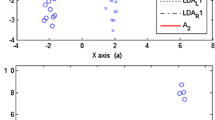Abstract
This paper proposes a novel nonparametric discriminant analysis criterion, named weighted marginal discriminant analysis (WMDA), whose purpose is to efficiently utilize the marginal information of sample distribution in the discriminant analysis. The local mean is calculated by using the data points near the margin with different weights. The more contributions to the margin information, the larger weights the data points have. By making use of the weighting strategy and local mean, WMDA simultaneously utilizes the marginal information and local structure which are important for discriminative feature extraction. Experiments on the artificial and real database show that the proposed WMDA is superior to other related methods.









Similar content being viewed by others
References
Fisher Ronald A (1936) The use of multiple measurements in taxonomic problems. Ann Eugen 7(2):179–188
Fukunaga K, Mantock JM (1983) Nonparametric discriminant analysis. TPAMI 5(6):671–678
Bressan M, Vitrià J (2003) Nonparametric discriminant analysis and nearest neighbor classification. Pattern Recognit Lett 24(15):2743–2749
Kuo B-C, Landgrebe David A (2004) Nonparametric weighted feature extraction for classification. Geosci Remote Sens 42:1096–1105
Yan S-C, Xu D, Zhang B-Y, Zhang H-J, Yang Q, Lin S (2007) Graph embedding and extensions: a general framework for dimensionality reduction. TPAMI 29:40–51
Li Z-F, Lin D-H, Tang X-O (2009) Nonparametric discriminant analysis for face recognition. TPAMI 31(4):755–761
He R, Hu BG, Yuan X-T (2009) Robust discriminant analysis based on nonparametric maximum entropy. Adv Mach Learn 5828:120–134
YangRan N, He R, Zheng W-S, Wang X (2012) Robust large margin discriminant tangent analysis for face recognition. Neural Comput Appl 21(2):1–11
He R, Sun Z, Tan T, Zheng W-S (2011) Recovery of corrupted low-rank matrices via half-quadratic based nonconvex minimization. In: CVPR 2889–2896. doi: 10.1109/CVPR.2011.5995328
He R, Hu B-G, Yuan X, Zheng W-S (2010) Principal component analysis based on non-parametric maximum entropy. Neurocomputing 73:1840–1852
He R, Hu B-G, Zheng W-S, Kong X-W (2011) Robust principal component analysis based on maximum correntropy criterion. TIP 20:1485–1494
Qiu X, Wu L (2005) Face recognition by stepwise nonparametric margin maximum criterion. ICCV. IEEE 2:1567–1572
Gu Z, Yang J, Zhang L (2010) Push-pull marginal discriminant analysis for feature extraction. Pattern Recognit Lett 31(15):2345–2352
Zeng Q-S, Wang C-D (2010) NPDA/CS: improved non-parametric discriminant analysis with CS decomposition and its application to face recognition. In: ICIP 4537–4540
Fukunaga K (1990) Statistical pattern recognition. Academic Press, San Diego
Belhumeur Peter N, Hespanha Joäo P, Kriegman David J (1997) Eigenfaces vs. fisherfaces: recognition using class specific linear projection. TPAMI 19(7):711–720
Dai DQ, Yuen PC (2003) Regularized discriminant analysis and its application to face recognition. Pattern Recognit 36:845–847
Friedman J (1989) Regularized discriminant analysis. J Am Stat Assoc 84:165–175
Price JR, Gee TF (2005) Face recognition using direct, weighted linear discriminant analysis and modular subspaces. Pattern Recogn Lett 38:209–219
Zhao D, Lin Z, Xiao R, Tang X (2007) Linear Laplacian discrimination for feature extraction. In: CVPR 1–7
Zheng W-S, Lai J-H, Yuen PC (2009) Perturbation LDA: learning the difference between the class empirical mean and its expectation. Pattern Recognit 42:764–679
Jonathan JH (1994) A database for handwritten text recognition research. TPAMI 16:550–554
Sim T, Baker S, Bsat M (2003) The CMU pose, illumination, and expression database. TPAMI 25(12):1615–1618
Acknowledgments
The author would like to thank the anonymous reviewers for their critical and constructive comments and suggestions. This project was supported by the NSFC (61173084,51074097), GuangDong Program (2010B031000004) and GuangZhou Program (2011J4300046).
Author information
Authors and Affiliations
Corresponding author
Rights and permissions
About this article
Cite this article
Zeng, Q. Weighted marginal discriminant analysis. Neural Comput & Applic 24, 503–511 (2014). https://doi.org/10.1007/s00521-012-1293-7
Received:
Accepted:
Published:
Issue Date:
DOI: https://doi.org/10.1007/s00521-012-1293-7




